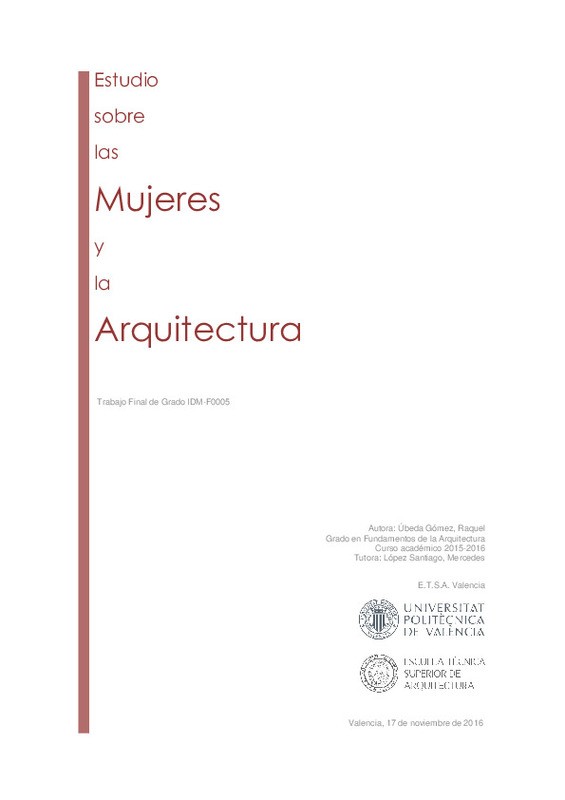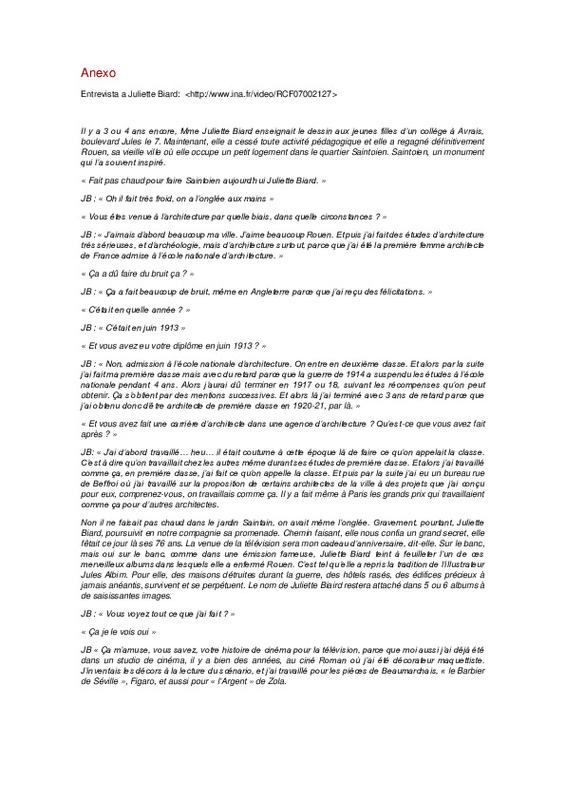JavaScript is disabled for your browser. Some features of this site may not work without it.
Buscar en RiuNet
Listar
Mi cuenta
Estadísticas
Ayuda RiuNet
Admin. UPV
Estudio sobre las Mujeres y la Arquitectura
Mostrar el registro sencillo del ítem
Ficheros en el ítem
| dc.contributor.advisor | López Santiago, Mercedes
|
es_ES |
| dc.contributor.author | Úbeda Gómez, Raquel
|
es_ES |
| dc.date.accessioned | 2018-02-09T17:20:16Z | |
| dc.date.available | 2018-02-09T17:20:16Z | |
| dc.date.created | 2016-11-17 | |
| dc.date.issued | 2018-02-09 | es_ES |
| dc.identifier.uri | http://hdl.handle.net/10251/97626 | |
| dc.description.abstract | [ES] A lo largo de la historia la mujer ha sido relegada a un plano de subordinación con respecto al hombre, en todos los ámbitos. En el campo de la arquitectura, la incorporación de la mujer ha sido un proceso lento y difícil que, aun hoy en día, está vigente puesto que las desigualdades salariales y de asignación de poder en el trabajo siguen existiendo. Sin embargo, en este contexto discriminatorio existen arquitectas que han desempeñado su profesión. Este es el caso de la primera arquitecta española, Matilde Ucelay, y de la primera francesa, Juliette Biard, que ejercieron su profesión a principios del siglo XX, así como el de Charlotte Perriand, que trabajó a la sombra de Le Corbusier. Actualmente, dos arquitectas contemporáneas, Carme Pinós (española) y Odile Decq (francesa), están dejando su impronta en esta profesión tradicionalmente masculina. La necesidad de visibilización de la mujer en la arquitectura se evidencia igualmente por la creación de premios exclusivamente femeninos (fenómeno repetido en otros campos profesionales como la escritura o la ciencia). Para conseguir que la perspectiva de las mujeres se refleje en la arquitectura es necesario repensar los parámetros y principios de la disciplina tradicional y proponer nuevas alternativas para construir, tanto el espacio público como el privado, para fomentar una participación igualitaria en los mismos, para evitar la jerarquización y conseguir que la arquitectura sea creada por y para todos. | es_ES |
| dc.description.abstract | [EN] Throughout history, women have been relegated to a level of subordination with regard to men, in all areas. In the field of architecture, the incorporation of women has been a slow and difficult process which is still ongoing nowadays because of the remaining wage and power distribution inequalities. Nevertheless, in this discriminatory context, there are female architects who have performed in their profession. This is the example of the first Spanish female architect, Matilde Ucelay, and the first French one, Juliette Biard, both from the XX century, as well as Charlotte Perriand, who worked in the shadow of Le Corbusier. Currently, two contemporary female architects, Carme Pinós (Spanish) and Odile Decq (French), are making an impact in this traditionally male profession. The need of increasing the visibility of women in architecture is also evidenced by the creation of prizes exclusively for women - this phenomenon has been repeated in other fields such as science and writing. In order for the female perspective to be reflected in architecture it is imperative to rethink the parameters and principles of the traditional discipline and come up with new alternatives to build, both in the private or public spaces; to encourage equal participation; to avoid hierarchy and achieve an architecture created by everyone and for everyone. | es_ES |
| dc.format.extent | 55 | es_ES |
| dc.language | Español | es_ES |
| dc.publisher | Universitat Politècnica de València | es_ES |
| dc.rights | Reserva de todos los derechos | es_ES |
| dc.subject | Architecture | es_ES |
| dc.subject | Architecture and gender | es_ES |
| dc.subject | Women | es_ES |
| dc.subject | Visibility | es_ES |
| dc.subject | Arquitectura | es_ES |
| dc.subject | Arquitectura y género | es_ES |
| dc.subject | Mujeres | es_ES |
| dc.subject | Visibilidad | es_ES |
| dc.subject.classification | FILOLOGIA FRANCESA | es_ES |
| dc.subject.other | Grado en Fundamentos de la Arquitectura-Grau en Fonaments de l'Arquitectura | es_ES |
| dc.title | Estudio sobre las Mujeres y la Arquitectura | es_ES |
| dc.type | Proyecto/Trabajo fin de carrera/grado | es_ES |
| dc.rights.accessRights | Abierto | es_ES |
| dc.description.bibliographicCitation | Úbeda Gómez, R. (2016). Estudio sobre las Mujeres y la Arquitectura. http://hdl.handle.net/10251/97626 | es_ES |
| dc.description.accrualMethod | TFGM | es_ES |
| dc.relation.pasarela | TFGM\21733 | es_ES |
Este ítem aparece en la(s) siguiente(s) colección(ones)
-
ETSA - Trabajos académicos [4687]
Escuela Técnica Superior de Arquitectura







